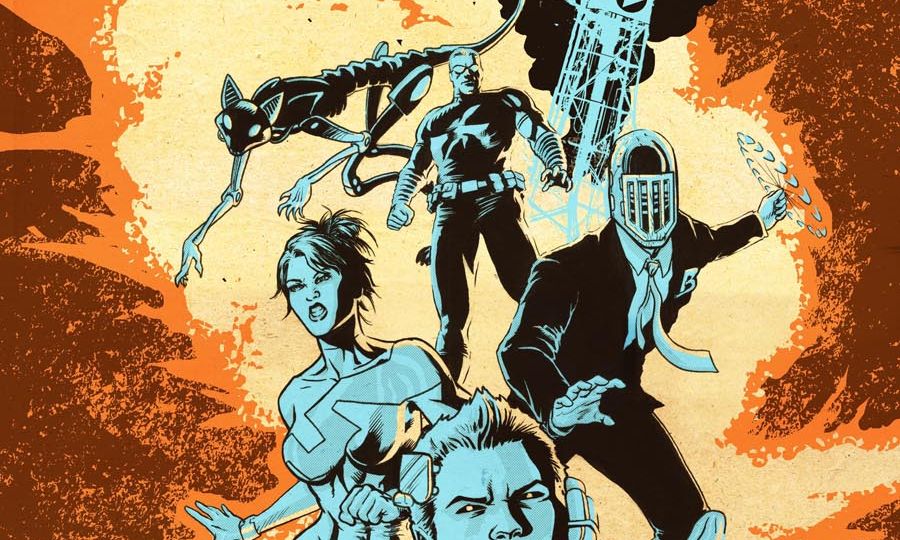
Vitruvian Underground is an awesome independent comic that I recently reviewed, and I talked to the creators of the book about the origins of the idea and their creative process. Ramon Villalobos wrote and colored the comic, but he’s also an extremely talented artist in his own right. Craig Cermak II penciled, inked, and lettered the comic, and you can also see his work on Dynamite’s Voltron Year One.
ComicBooked: As a comic artist yourself, Ramon, what’s it like to work as a writer with another comic book artist? Do you think that your artistic background helps your writing collaboration with Craig?
Ramon Villalobos: I think in a way it does, just because when Craig and I both decided to do the Vitruvian Underground we did it like explicitly as a book that we wouldn’t be able to do if some other writer came on. We get scripts a lot from different people and a lot of times they’re pretty awful, and they’re just like generic and kind of boring. So we were talking about that because our friend was asking us if we wanted to do stuff.
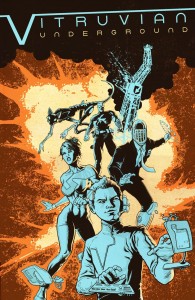 Craig Cermak II: Or even people we didn’t really know. Just like random people would email us stuff, like oh you should work on this book for me, and then you’d be like well…because you don’t want to be mean and just blow them off, you’d say well send me a script and I’ll check it out. Most times it was just not…
Craig Cermak II: Or even people we didn’t really know. Just like random people would email us stuff, like oh you should work on this book for me, and then you’d be like well…because you don’t want to be mean and just blow them off, you’d say well send me a script and I’ll check it out. Most times it was just not…
Ramon: It’s just not interesting from an artistic point of view because we’re superhero fans first and foremost, I think, in comic books, and you don’t get a lot of that stuff. You get a lot of paranormal investigators, that happen to be like a mummy, or a zombie, or a Mexican wrestler, or something, and it’s sort of like they’re similar tropes of independent comic books that people like to keep recycling. And it didn’t appeal to me, and I don’t think it appeals to you, right Craig?
Craig: No, no…our thing was we want to do more superhero stuff, and everyone had something that would be more like a short story with the tropes you were talking about. It’s kinda like the same thing, just replace these adjectives or something you know. It’s not really appealing.
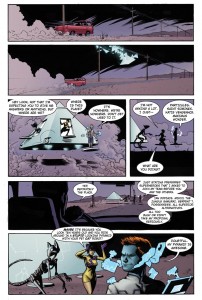 Ramon: Yeah and you know, we’re big fans of silver age comics, we have a very similar sensibility, so we approached it like everything was 50/50 collaboration. Every character that we created pretty much was a mixture of both of our ideas, down to the designs, so I think it was probably different writing for him as an artist in that I approached it from a visual standpoint first, you know what I mean? I thought what would I want to draw, and then as it went on I would be like, Oh man I really wish I was drawing this stuff.
Ramon: Yeah and you know, we’re big fans of silver age comics, we have a very similar sensibility, so we approached it like everything was 50/50 collaboration. Every character that we created pretty much was a mixture of both of our ideas, down to the designs, so I think it was probably different writing for him as an artist in that I approached it from a visual standpoint first, you know what I mean? I thought what would I want to draw, and then as it went on I would be like, Oh man I really wish I was drawing this stuff.
Craig: Too bad.
Ramone: Too bad I’m too slow to do that.
ComicBooked: Did you write a full script, or was it more sort of a Marvel style plot synopsis?
Ramon: No, what happened was we had talked about doing a story, and we approached it like that in the beginning, we both had an input on what we were gonna do story-wise, but I did write a script. The one thing that was different was that I didn’t include any dialogue, word balloons or captions
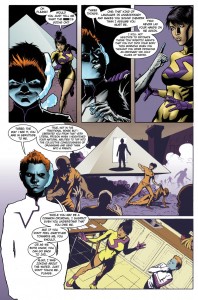 Craig: Yeah. There’s only some.
Craig: Yeah. There’s only some.
Ramon: Yeah, I would give indications of this is what they would be saying, or here’s an example of dialogue that might be in it but probably not.
Craig: It’s kind of like if something came to you, you put it in there.
Ramon: Yeah, and that was because I had done a Marvel style thing with a friend of mine and I really liked it, but I knew Craig was looking for someone to write something for him, as well as working with me. He wanted a script to work from because it’s easier that way than coming up with everything wholesale. So I kind of did a mixture of giving him a full script and letting him go off a plot synopsis. Grant Morrison and Mark Waid have talked in interview that they have done that, so I was like if they’re doing that, then I could probably try it out and see how it worked. And it was good in some places, and in some places it was less good because I wasn’t clear enough in the script, and so there was a little bit of misinterpretation, but those things got ironed out, and it’s fun to have that kind of problem solving.
Craig: Yeah. It makes it more interesting because you never really know what’s going to happen.
Ramon: It feels more organic, I think, when you read it, because it’s not so stiff.
Craig: We would talk frequently too, so if I ever had any questions, we would just talk about it. So if it’s not there in the script, we still knew about it.
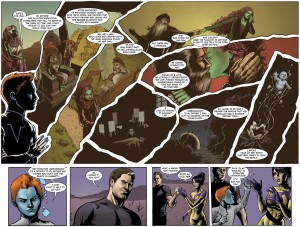 Ramon: It’s not like working with an editor or anything because we’re just talking to each other all the time anyways
Ramon: It’s not like working with an editor or anything because we’re just talking to each other all the time anyways
Craig: There was one scene in particular where he wrote something in the script and I had changed it after talking to him about how it wasn’t really possible to do it how he wrote it.
Ramon: Once he told me that, I was like that sounds like a clownish thing for me to write in the first place. Those kind of things iron themselves out when you’re working as closely as we were.
ComicBooked: Who are your major influences in terms of writing?
Ramon: Grant Morrison is a big one. That was definitely one of the guys who we both really like. We both really like his work a lot. Him, and then a lot of the silver age writers. I felt like they could do more with smaller spaces, but to be honest, I can’t think of any off the top of my head that spring to mind. Help me out Craig, who’s the Doom Patrol/Teen Titans guy?
Craig: Oh, Bob Haney?
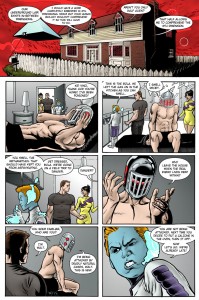 Ramon: Yeah, Bob Haney, because he’s just so crazy, and he tries to do weird things.
Ramon: Yeah, Bob Haney, because he’s just so crazy, and he tries to do weird things.
Craig: I think it’s more of a broad thing.
Ramon: The sensibilities of the silver age writers, without picking specifics…
Craig: Because they weren’t perfect either.
Ramon: No, no, there was definitely awkward stuff going on in there. One of the things I feel pretty strongly about is that you shouldn’t be drawing too much influence from comic books themselves, because then it feels too insular, and it’s harder for people who don’t read comics to read that book. So I read a lot of other books that aren’t comics in general, and I try not to make anything too self referential in Vitruvian Underground. I used to read a lot of plays in high-school… Arthur Miller was the guy, Eugene O’Neill, Tenessee Williams, the American playwright. Then I read a lot of Michael Chabon because he does write about comics, but its not comic books themselves. David Sedaris is really funny.
ComicBooked: Where did the idea for the Vitruvian Underground originate?
Ramon: Well, Craig actually approached me about doing a book. He was in school, and he wanted sometihng to work on. We wanted to do a team book because we had met in a fan fiction, fan art forum, so we both knew that we were big fans of DC Comics. We loved especially 1960’s DC Comics team books, like Teen Titans, Legion of Superheroes, Justice League, Doom Patrol, those kinds of things. We wanted to make a team full of archetypal characters, to make like basically the perfect 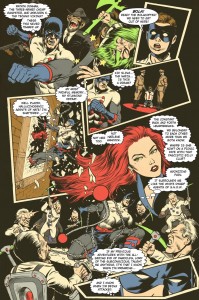 comic book superhero team. We approached it kind of like the way they decided to make The Monkees, prefabricated stuff like that. We wanted two girls, two guys, and something in between like a robot or a kid, and we ended up with both of those, and we only got one girl, but then we approached it like alright, what powers do we have? Everything sort of worked backwards from the angle of having our favorite superhero team. I think Craig came up with Kid Vinci primarily, but I don’t know, he said that I did.
comic book superhero team. We approached it kind of like the way they decided to make The Monkees, prefabricated stuff like that. We wanted two girls, two guys, and something in between like a robot or a kid, and we ended up with both of those, and we only got one girl, but then we approached it like alright, what powers do we have? Everything sort of worked backwards from the angle of having our favorite superhero team. I think Craig came up with Kid Vinci primarily, but I don’t know, he said that I did.
Craig: It was a blend.
Ramon: We both threw ideas at it. Same thing with Bola and Walt and Stampede. They were ideas that were able to represent different symbols in society and stuff more so than the actual characters. Now, we feel like they’re very defined, but at first, we just wanted a girl, we wanted a kid, we just wanted a silver age superhero in it, and it kind of worked backwards.
ComicBooked: Yeah, you even comment on that in the comic itself. You have them talk about how it’s the paradigm of the team set up by Kid Vinci, in terms of you got a wild card, you have the brains, you have the muscle….
Ramon: Right, and that was kind of directly lifted from It’s Always Sunny in Philadelphia, but its a good reference. I thought it was great when I heard it, and I thought it was great when I stole it.
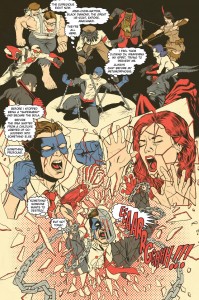 ComicBooked: So Vitruvian Underground comes across as something of a counterculture superhero team, almost like The Invisibles if the Invisibles were superheroes. Do you think that Vitruvian Underground has a sort of alternative feel to it?
ComicBooked: So Vitruvian Underground comes across as something of a counterculture superhero team, almost like The Invisibles if the Invisibles were superheroes. Do you think that Vitruvian Underground has a sort of alternative feel to it?
Ramon: Well, I think it’s very independent, and when I talked to Craig about doing it, I said I didn’t want them to ever be in a city, because I wanted them to feel like they’re on the outer edges of society. Especially with the name Vitruvian Undergorund. I don’t think Craig wanted to use it, but I wanted a team name that didn’t sound like it had been used before, and Underground, like Velvet Underground, Weather Underground, there’s been lots of counter culture groups with the Underground part of the name in it, and so it definitely implies that when you first hear it. The Vitruvian thing was a reference to Kid Vinci’s dad, but yeah, I mean, I think it was by design supposed to feel independent, because that’s what it is.
Craig: We did not want to do where they’re based in a city like New York…something in comics that bugs us is that there’s not enough things going on around the world within a comic book, and someone who does that really well is Grant Morrison, so we’re influenced by him, so we wanted to do that, where they can go anywhere. To make that possible, their home base is not in any particular spot on Earth. It’s existing within a different realm.
Ramon: It’s in between dimensions where their home base is. Yeah, we definitely were inspired by Morrison, like The Invisibles, so we wanted it to feel kind of cool and hip, and also because the other thing I’ve seen a lot of is analogies to Justice League. I don’t think the world needs anymore of we got a Batman, a Superman, and a Wonder Woman, we’ll just slightly alter them, so that’s why Vitruvian Underground completely avoids that. We wanted something that felt new, and that’s why they dont even wear similar colors. They look better all standing out from one another. It looks like they’re designed by completely different people and they’re put together. I think it helps the feel of an underground, rag tag team. What’s funny too is that we reference superheroes that we created that are in the first couple pages where we just list a bunch of superheroes who we spent a year creating for this book.
ComicBooked: Wow, so those are actual characters, not just names? Those are actual characters that you created?
Ramon: Those are actual characters that we’ve drawn, we’ve designed, we have back stories for them.
ComicBooked: Wow, that’s interesting.
Ramon: I was keeping a notebook for a while. I was trying to at least come up with one thing a day, like villains or characters to support the cast. I think Craig came up with Particules, which I thought was cool. Saint Sominex was one that I came up with. Almost all those characters had villains that were created specifically for them, in the event that we ever branch off and do that stuff. Our favorite character in that book somehow became the Bola. That was entirely Craig, but we’ve got more characters created for him than anyone else in the book. Even more than the Vitruvian Underground themselves.
Craig: Yeah, he was a silver age character, so we came up with all these silver age villains that he would have fought at one point.
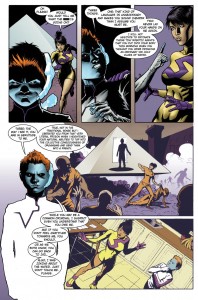 Ramon: And you see eight or nine or ten of them in the book. And again, every one of those characters has a back story.
Ramon: And you see eight or nine or ten of them in the book. And again, every one of those characters has a back story.
ComicBooked: When you wrote this first issue, did you write it with a finite story arc in mind, or is the story of the Vitruvian Underground something that would exist as a six issue miniseries, or could it be an ongoing?
Ramon: Well, here’s the thing. I don’t really like it when independent books have more than one issue unless you know that they’re gonna come out in any kind of regular pace, so they’re all single issues. We want it to be when you see an issue of Vitruvian Underground, you don’t have to have any context. Actually, in the first issue, I didn’t want to get into any origins. I just wanted to kind of go into it without wasting any time, but Craig was like that didn’t make any sense because then people won’t care about these characters, and you know what, he had a point. That first issue, we tried as best as we could to pace it out and make it fluid, but that’s a one and done issue, and you’re never going to see that storyline picked up in another thing, maybe referenced. We have four or five stories after this that we want to tell that are all single issue things. I’m just saying that unless it’s something that was bigger, I wouldn’t even want to do a six issue miniseries. I would rather just do collections of stories, the way you would see in a Showcase book where you could flip through it and see all these different crazy ideas, and it’s not like one continuing story.
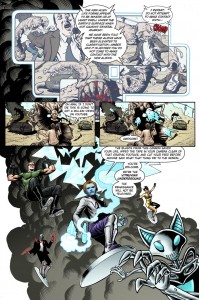 ComicBooked: Do you think there’s going to be more issues of this series on the horizon?
ComicBooked: Do you think there’s going to be more issues of this series on the horizon?
Ramon: Oh, definitely. We’re always talking about when we’re going to have enough time to do the second one, but Craig’s working on a monthly book, which is, you know, a lot of work. But we have pages from other issues drawn up and colored and written. What we need to do is finish one of them. We want to have one of them done at least by the end of this year. If it’s a one a year thing for us, that wouldn’t bother us that much because we’re doing other stuff in the mean time. This is, to me, I can’t speak for Craig, but it’s like the best comic book that I could possibly be doing stuff on. This is concentrated everything that I love about comic books in general. Ideally, I would like to do a long chunk of it, but it’s time consuming.
Craig: It’s a time and money thing. You’ve got to financially support yourself doing other stuff, and that eats up that time.
Ramon: We’re all about time and money over here at Club Chevon.
You can see buy the first issue of Vitruvian Underground here, and you should do so immediately, because it’s awesome. Limited quantities are available.















